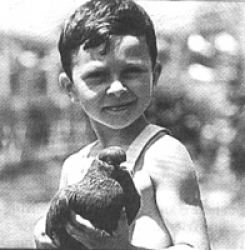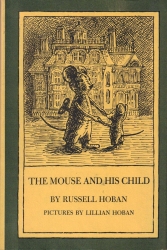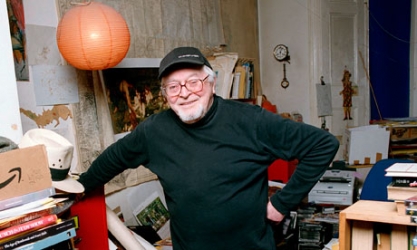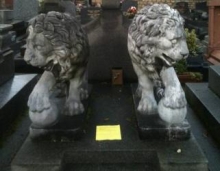Russell Hoban biography: summary
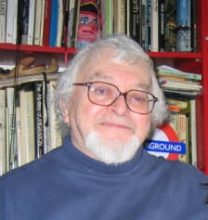 Russell Hoban (1925-2011) was an American novelist and children's writer. Born in Philadelphia, he was decorated for service in WWII. Working as a commercial illustrator and advertising copywriter, he achieved recognition for his popular Frances the Badger series from 1960, and in 1968 he published his first full-length book, The Mouse and His Child, widely regarded as a children's classic. He lived with his first wife Lillian Hoban, who illustrated many of his early books, and their four children in Connecticut until 1969, when he moved to London. He was to spend the rest of his life in his adopted city, marrying Gundela Hoban in 1975 and having three more children. In 1973 he published his first adult novel, The Lion of Boaz-Jachin and Jachin-Boaz. Other books followed and in 1980 he published Riddley Walker, the highly-acclaimed award-winning novel for which he was to become most renowned. Further novels followed including Pilgermann (1983) and The Medusa Frequency (1987). From the late 1990s to his death he published a new novel, including Amaryllis Night and Day (2001) and Linger Awhile (2006) almost annually. His last novel, Angelica Lost and Found, was published in 2010, while the much praised young-adult story Soonchild and the young children's book Rosie's Magic Horse were published posthumously, in March and October 2012 respectively.
Russell Hoban (1925-2011) was an American novelist and children's writer. Born in Philadelphia, he was decorated for service in WWII. Working as a commercial illustrator and advertising copywriter, he achieved recognition for his popular Frances the Badger series from 1960, and in 1968 he published his first full-length book, The Mouse and His Child, widely regarded as a children's classic. He lived with his first wife Lillian Hoban, who illustrated many of his early books, and their four children in Connecticut until 1969, when he moved to London. He was to spend the rest of his life in his adopted city, marrying Gundela Hoban in 1975 and having three more children. In 1973 he published his first adult novel, The Lion of Boaz-Jachin and Jachin-Boaz. Other books followed and in 1980 he published Riddley Walker, the highly-acclaimed award-winning novel for which he was to become most renowned. Further novels followed including Pilgermann (1983) and The Medusa Frequency (1987). From the late 1990s to his death he published a new novel, including Amaryllis Night and Day (2001) and Linger Awhile (2006) almost annually. His last novel, Angelica Lost and Found, was published in 2010, while the much praised young-adult story Soonchild and the young children's book Rosie's Magic Horse were published posthumously, in March and October 2012 respectively.
Russell Hoban - biography
Certainly I was read to a bit as a child, enough to instil it in me, and I was given plenty of books as a child, and I still remember my father - who was a socialist, but I guess he would have to be called a communist sympathiser at the time – used to bring me books – I remember one called Fairytales for Workers’ Children, a collection of hard-luck stories. There was a little black guy, and a yellow dog who had a terrible time. Left its mark on me, I can tell you... The first two rules of etiquette that I learnt were always to eat the label on the pumpernickel for good luck, and never to cross a picket-line. My father was put in jail for marching in a picket-line at the hosiery mill, which was the local industry in Lansdale.
- A Conversation with Will Self (2011)
After briefly attending Temple University, at age 18 Russell enlisted in the Army and served in the Philippines and Italy as a radio operator during World War II, earning a Bronze Star. As recounted by Will Self in 2011,
while Russell was serving in the signals corps, his sense of direction had been so poor that he was continually getting lost. "The Germans saw me going by so many times," he said, "they probably thought I was an entire company on the move."
- Russell Hoban, My Hero, The Guardian (2011)
During his military service, in 1944, he married his first wife, Lillian Aberman, a fellow illustrator he met at the Graphic Sketch Club in Philadelphia. The couple also studied together at the Philadelphia Museum School. They set up home in Wilton, Connecticut and went on to have four children, Phoebe, Abrom, Esmé, and Julia.
In 1959 Russell published his first children's book, What Does It Do and How Does It Work, which he both wrote and illustrated. In 1960 he published Bedtime for Frances, the first in the "Frances the Badger" series. With all but the first illustrated by Lillian Hoban, these were probably Russell's most famous children's titles. Around this time he taught drawing at the School of Visual Arts in New York and worked as a freelance illustrator, painting several covers for TIME (Joan Baez, Jackie Gleason), Sports Illustrated (Rafer Johnson), and The Saturday Evening Post, as well as books including the 1965 Macmillan Classics edition of Tales and Poems of Edgar Allan Poe and an edition of J.D. Salinger's The Catcher in the Rye.
After working "about 20 low-level jobs", Russell joined Batten Barton Durstine & Osborn as an advertising copywriter. His first son Brom recalls "an ad for a Sony stereo he wrote: 'With this sound system, the Rolling Stones won’t sound like falling rocks.'" Later Russell became the art director of J. Walter Thompson. In 1987 in his keynote address for the Sixth Annual Literary Conference of the Manitoba Writers' Guild, he said:
Russell spent some years writing his first full-length novel The Mouse and His Child part-time, commuting into the office early after "barely five hours' sleep" and taking an extended lunchbreak to work on the manuscript. The book was published in 1968: widely regarded as a children's classic, Russell himself said he thought of it as his first novel, rather than a book strictly for children. It was made into an animated film in 1977, featuring the voices of Peter Ustinov and Chloris Leachman. A theatrical version was produced by the Royal Shakespeare Company in Stratford, England, in 2012-13.Risk-taking was a big thing in my mind at the time [the early 1960s]. Only a year before I’d left my TV art director job to become a freelance illustrator. That was a risk I’d hesitated to take: I had a wife and three children and a mortgage, I was a responsible citizen with a lot to lose. One evening coming home on the train I’d said to my friend Harvey Cushman, who worked at another advertising agency, “When I have $10,000 in the bank and a couple of steady accounts I’ll do it.” “You’ll never do it then,” said Harvey. “I’ve heard lots of guys say the same thing and somehow the time never comes. If you’re going to do it you’ll do it without the $10,000 and the steady accounts.” So I did it and I prospered and I was confirmed in my belief that the human being is a hunting and finding and risk-taking animal.
- The Bear in Max Ernst’s Bedroom or The Magic Wallet (1987)
From 1967 Russell was finally earning sufficient royalties from his children's books to write full-time, but he was diagnosed with diabetes and other conditions and began to suffer writer's block. In 1969 he moved his family to London, partly because he was drawn to the city of some of his favourite writers including Charles Dickens, Joseph Conrad and M.R. James, and partly in an effort to shake the block.
London has a hold on me. This town has been very good to me in providing settings for my stories. Because London has become the place of my heart I am encouraged to believe that it puts heart into the comings and goings of the people in my books. And of course I see it through a foreigner's eyes, taking nothing for granted and constantly responding with what might be called an innocent eye. I felt myself a stranger and an outsider in my own country, but being a stranger where I actually am a stranger feels good.
- interview with Bloomsbury Publishing, 2004
The move was originally intended to be for two years, but Russell suffered a midlife crisis and found himself unable to return to the U.S. The Hobans' marriage broke up and Lillian returned to Connecticut with their children. Though her collaborations with Russell ended, Lillian continued to write and illustrate children's books, including some collaborations with their daughter Julia (to whom Bread and Jam for Frances is dedicated).
In 1970, Russell met Gundela Ahl who was working at the London bookshop Truslove and Hanson.
She was twenty-seven then, taller than I, with the sort of old-fashioned beauty one sees in antique dolls... She sold me The Oxford Classical Dictionary as well as eight other books of which the last was Giordano Bruno and the Hermetic Tradition; I still haven't read it and I don't ever expect to but I'd have bought whatever she showed me.
- The Medusa Frequency (1987), chapter 4
Russell and Gundela married in 1975 and several of his books are dedicated to her and the children they went on to have - Jachin (Jake), Ben, and Wieland.
Adult novels and writing practices
In 1973 Russell published his first adult novel, The Lion of Boaz-Jachin and Jachin-Boaz, with Kleinzeit and Turtle Diary following in 1974 and 1975 respectively. Riddley Walker, published in 1980, was and remains his biggest publishing success, making the bestseller lists in the U.S. and garnering several awards, including the John W. Campbell Memorial Award in 1982, and the Australian Science Fiction Achievement Award in 1983. Pilgermann followed in 1983 and The Medusa Frequency in 1987. In 1985 Turtle Diary was made into a film starring Ben Kingsley and Glenda Jackson, with a script by Harold Pinter, but no new novels were forthcoming until 1996. In 2004 Russell told Colin Midson of Bloomsbury Publishing:Between The Medusa Frequency (1987) and Fremder (1996) I wrote the libretto for The Second Mrs Kong [an opera collaboration with Sir Harrison Birtwistle]. Also The Trokeville Way plus two or three picture books for children, several short stories for Granta and Fiction Magazine, some stories for BBC Radio 4 and a piece for Radio 3 on the music of William Lawes (Perfect and Endless Circles). Also Bury My Heart at Auschwitz for Dimensions magazine. The rest of the time I must have frittered away...
Following the publication of Fremder, Russell published a new novel almost annually. Towards the end of his life he became increasingly housebound, with Charcot foot and failing eyesight among other ailments, but continued to put in long hours at his desk. His daily routine tended to be to get up around 8am, have breakfast while reading The Times and The Guardian (newspaper reports often prompted ideas for stories), work until noon and then have lunch watching a film on video or DVD. He would then take a nap in the mid-afternoon and start work again, breaking for dinner while he watched his second film of the day. He would then stay up writing until around 3am.
I find that in order to tune in to things I have to spend about ten hours a day at my desk. I have to stay up late and let the night into me so that the bricks of reason move apart and the other comes in through the cracks. The electric light changed a lot of things. It was an Irish writer, maybe Padraic Colum but I'm not sure, who said that traditional story-telling had to do with the circle of the firelight and the night all round. When electricity banished the night something was lost. So you have to let the night back in because it's the mother and the mother is where everything comes from... you have to listen to what wants to speak to you.
- The Bear in Max Ernst's Bedroom (1987)
This clip from a 1990 reading and Q&A session at San Diego State University shows Hoban talking about some of the ways he gets his writing moving. Skip to 23m 55s or go here for the relevant section.
Russell worked in a rambling (some might say chaotic) study which he called his "exobrain", actually a large reception room at the front of the upper ground floor of his house in Fulham. Surrounding his desk were
The walls were lined with bookshelves and hung with maps and art prints. There were a couple of chairs and a TV set. A Mr Punch head leered out from a bookshelf, a Meissen figurine rolled a golden ball on the mantelpiece. Visitors would attest to the difficulty of navigating the room even for a fully able-bodied person. Sometimes Russell would search in vain amongst the stacks for a book he wanted to refer to and end up ordering a new copy from Amazon simply because it was quicker. His desk was festooned with computer and stereo equipment (he generally had music playing as he wrote, usually instrumental classical, opera or jazz), as well as keepsakes, postcards and trinkets, as described in books such as The Medusa Frequency. In the 1980s he started using an Apple II computer for both VAT calculations and writing, and although later he used a modern PC he chose to use an old DOS-based word processing program as he found it less distracting than the likes of Microsoft Word. Russell typed, wrote or printed on yellow paper since at least the early 1970s (it was embodied as a character in 1974's Kleinzeit):tottering stacks and shaky heaps of DVDs and videos, bulging shelves of books, slithery carpets of undiscarded draft pages, and delicately balanced objects of various weight and fragility poised to fall on my head. I have often been buried under DVD slides and video-topplings and once the TV fell on me while I was trying to squeeze between it and a precarious stack.
- Writers' Rooms, The Guardian (2007)
One of the earliest symptoms [of writer's block] is a growing dread of blank paper, and at this stage preventative action may still have some effect; certainly, in the mind-to-paper process, one’s choice of paper is important. I always use 80-gram yellow A4; it’s the kind of yellow the paper manufacturers call gold, and gold is what one is trying to refine the base metal of one’s thoughts into, isn’t it... I never use white paper - to intensify the blankness of a blank sheet by using white paper is to run to meet trouble considerably more than halfway.
- Blighter's Rock (1989)
Having been published since 1973 by Jonathan Cape, Russell moved with his longtime editor Liz Calder to Bloomsbury Publishing in 1998, considering himself "supported by" Bloomsbury's Harry Potter. He was represented for many years by Bruce Hunter at the literary agency David Higham & Co, and then by Andrew Gordon.
In 2002 a fan activity dubbed The Slickman A4 Quotation Event (SA4QE) started, in which readers of Russell's books would leave their favourite quotations in public places to celebrate his birthday. The event celebrated its own 10th anniversary in 2012. A website was created to record the quotations chosen by participants.Words have a life; without response, they die.
- Russell Hoban, commenting on SA4QE
In 2005 the worldwide collective of Russell Hoban enthusiasts calling themselves The Kraken organised the first international fan convention in Russell's honour. Dubbed The Russell Hoban Some-Poasyum (a pun on "symposium" from Riddley Walker), the event took place in London shortly after the author's 80th birthday and comprised a dinner at Russell's favourite restaurant, Il Fornello in Holborn, a tour of some of the many London locations referred to in the novels, a visit to Canterbury Cathedral paying homage to Riddley Walker and a reading by Russell from his then new novel Come Dance With Me. The convention was co-organised by Dave Awl, an American writer-performer who had put together the first Russell Hoban website, The Head of Orpheus, in 1998 and begun The Kraken discussion forum a year later. Russell would often send Dave news and previews of manuscripts which featured on the site.
In 2007 the Red Kettle Theatre Company produced Riddley Walker from Russell's own script in Waterford, Ireland. Between late 2010 and early 2011 Russell took part in a number of media activities to promote the 30th anniversary of Riddley Walker as well as what was to become his final novel, Angelica Lost and Found. His appearances comprised an interview at the Serpentine Map Marathon event, an evening for the Guardian Book Club series and an entertaining conversation with novelist Will Self at the British Library. In autumn 2011 the Trouble Puppet Theatre Company in Austin, Texas staged a puppet version of Riddley Walker. Russell was supportive of the production.
Russell Hoban died aged 86 on 13 December 2011 in London, two months after being admitted to hospital following an episode of heart failure. He was cremated on 4 January 2012 at Mortlake Crematorium, London.
In March 2012 Russell's final full-length book, the young-adult story Soonchild, was published by Walker Books. Russell had often talked of how proud he was of the book and that his only wish was to live to see it in print. He did actually see final bound copies in hospital, and the book was very well received, with excellent reviews and a shortlisting for the Guardian Children's Fiction prize. Rosie's Magic Horse, a book for young children with illustrations by longtime collaborator Quentin Blake, was published by Walker in October 2012, while a new short story, Message in a Klein Bottle, specially commissioned for the Kensington & Chelsea Exhibition Road Show, premiered as part of the festival's "Road Stories" in August 2012. In 2017 the Beinecke Library of Yale University acquired Hoban's archive of manuscripts, notebooks and diaries; more information is available here.
Richard Cooper
The Head of Orpheus
Wikipedia
Yvonne Studer, Ideas, obsessions, intertexts: a nonlinear approach to Russell Hoban's fiction (Francke Verlag, 2000)
Russell Hoban, The Illustrator, Chris Bell
Russell Hoban interview with Colin Midson of Bloomsbury, The Russell Hoban Some-Poasyum
Writers' rooms, The Guardian
The Slickman A4 Quotation Event
Kensington & Chelsea Exhibition Road Show
Russell Hoban, My hero by Will Self, The Guardian
Secrets of the yellow pages, The Guardian
Lord of the Kraken, The Scotsman
1975 article by Russell Hoban
80 at 80 article by Brom Hoban
Some descriptive and anecdotal elements contributed by Richard Cooper
Russell Hoban portrait in the biography summary at very top of this page by Lisa Greenstein

